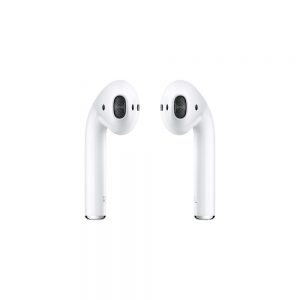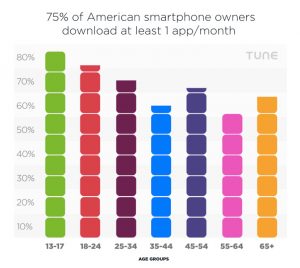 Based on my speech at a recent Brand Innovators summit.
Based on my speech at a recent Brand Innovators summit.
Five of the most powerful tech companies in the world have just formed an alliance to understand and control the development of artificial intelligence. Two companies that are still pimple-cheeked juveniles, historically speaking, have captured more than half the global market for mobile advertising. And almost every one of the billion-dollar brands built in the past decade has been built on a one-to-one unmediated relationship with its customers.
The times are not just a-changing, they are exploding with innovation.
At TUNE, our mobile measurement technology is in 2.2 billion devices globally. We see data from all over the world, and that gives us a perspective few can equal. Here are a few observations and five trends drawn from that vantage point.
Trend 1: Mobile is not a channel
 Traditional brands and traditional companies still more often than not view mobile as a channel, one of many ways to communicate people and convert them to customers. In 2016, this view is no longer tenable.
Traditional brands and traditional companies still more often than not view mobile as a channel, one of many ways to communicate people and convert them to customers. In 2016, this view is no longer tenable.
- Email is a channel
- Video is a channel
- The web is a channel
- Push messages are a channel
- In-app messages also
- Social is a channel
- Messaging is a channel
Mobile is the ecosystem within which all of those channels exist.
Mobile now takes the majority of our digital minutes, passing desktop two years ago in 2014 and passing TV a year ago, in 2015. in the U.S., we were late to that party. Countries like India, with its billion+ mobile phones and 60M PCs, passed those points a long time ago. We read email, watch video, message each other, and post status updates primarily on mobile.
And this trend is doing nothing but increasing. In the UK, mobile now sucks up 33% more of people’s time than TV.
That’s led to smart companies reinventing themselves. A friend who works with AT&T’s marketing department recently told me that the company is focused so intently on mobile that when staffers are told not to bring marketing proposals that are not mobile-first: the message is, if it’s not mobile … don’t bring it.
Trend 2: Continuous ubiquitous intelligence augmentation

Apple AirPods
It’s obvious to most of us that Google makes us smarter.
What’s not quite so obvious is that this intelligence comes with dependencies. You need a laptop to search on, or a smartphone with an app. Even more fundamentally, you need to pay attention, perform actions, hold a device, tap on it or speak to it, then look at it, and get the data you’re seeking.
That paradigm is about to change.
Apple’s not a search giant, and it’s mission is not to organize the world’s information. But it will be leading the reinvention of how we access information and that reinvention will have massive implications for how the world’s data will augment our intelligence.
Interestingly enough, when Steve Jobs unveiled the first iPhone, he said the “killer app” was making calls. Because, of course, it was a phone, and that’s what phones did. Now no-one actually uses their phones to talk … or, at least, it’s a tiny fraction of what they do with their devices.
That’s about to change. But it’s not like we’re going back to talking to people. We’re going to talk to digital avatars. Personal digital assistants, but very different than Palm Pilots, the PDAs of the 90s.
For years that computer industry has been looking for places to put computers on our bodies. The most common place today is in your hand … your phone. But virtually every part of the body has been considered. Your face: Google Glass. Snapchat Spectacles, too, if you stretch the definition of what a computing device is. Your body, with smart bras and shirts. Your wrist, with Fitbits and other fitness bracelets. Shoes. Socks. Jackets.
Apple’s been looking too.
Obviously, Apple released a product for the wrist: Apple Watch. It’s a successful product — the best-selling smartwatch on the market — but the jury is still out on whether it’s a game-changer or not. Apple has also been looking at the head … more specifically the ears. I’m talking about Airpods.
And this will be a game-changer, because now you’ll have a ubiquitous constant digital companion. Just tap the Airpod in your ear and speak:
- Siri, where is the Empire State Building?
- Siri, where’s a place to eat?
- Siri, where’s my daughter?
- Siri, who is this woman I met at the conference?
- Siri, what’s my next appointment?
- Siri, what’s on my grocery shopping list?
Alexa is voice-and-ear as well, but for the home. Other personal digital assistants are moving to voice too, but require a device in your hand and attention from your eyes. But with AirPods, we’ll have continuous ubiquitous information, without having to physically look at something
That’s the game-changer.
Of course, version one will be limited, and the service will get better over time. And, arguably, Google might be able to a version of this better, or other industry players in artificial intelligence and devices, like Microsoft, Facebook, Amazon, perhaps IBM.
But Apple’s kicking off the game.
Trend 3: Apps’ demise greatly exaggerated, but yes, it’s coming
 comScore tells us that the average American downloads zero apps/month.
comScore tells us that the average American downloads zero apps/month.
That’s nonsense.
TUNE’s technology is in 2.2B devices globally, and in an average month, we touch 50-100M Americans. We touch many more devices than that, because most of us have between two and four devices. That’s a pretty nice sample size.
And, as we’ve posted about in detail, even if every American smartphone owner that we DO NOT see downloads zero apps per month, the number of apps American smartphone owners install in a month is still averages out to at least one per month
But of course it is true that things are changing. The industry is maturing and slowing down.
As that happens, apps will change too. We see the beginning of that in Google’s instant apps, apps you can use without installing. We see that in deeplinks, which link directly into contextually-relevant app screens right from the web. And we see that in universal links, which link to web pages or apps intelligently, depending on what you have available.
For brands right now, the web is top of funnel and apps are bottom of funnel. The web is discovery and apps are engagement. But, apps and web are converging, and the result will be better than either.
Trend 4: Bots are not the new apps
 You’ve probably noticed how quickly the hype cycle has roared through the bot or chatbot space.
You’ve probably noticed how quickly the hype cycle has roared through the bot or chatbot space.
Bots are amazing. Bots are incredible. Bots are the new new thing. Bots are the new apps. Bots have engagement issues. Bots have discovery issues. Bots have usability issues. Bots suck. Bots are horrible. Bots are so over before they even started.
The reality is that bots are going to be huge, but most people have no clue what they’re actually for. Bots are not for experiences, broadly speaking. (Everything is an experience, of course, but not everything is a deep, rich, engaging experience over time.)
Rather, bots are for action.
Chris Messina, inventor of the hashtag and current head of developer evangelism for Uber, says that Homo Mobilus exists in a state of continuous partial attention. This is what bots were made for: I tell a machine something I want done, it goes off and does it, it comes back and tells me.
Done. Check. Over. And maybe, rinse and repeat.
- Change my flight
- Cancel my reservations
- Buy the best available Mets tickets
- File a complaint
- Contest that traffic ticket (an actual, live bot use case)
- Re-order my favorite pizza
Bots are not for configuring products in detail. They’re not for shopping, in the sense that you’re browsing, comparing, experiencing, and trying products. Nor are they for extended conversations of tap-tap-tap text.
Instead, bots are for annoying stuff that otherwise you’d have to call an actual human — the horror — to get done.
Trend 5: AI will actually kill us all, but not the way we think
 When we think of artificial intelligence, we think of helpful Data from Star Trek or freaky HAL from 2001, A Space Odyssey, or murderous terminators from … The Terminator.
When we think of artificial intelligence, we think of helpful Data from Star Trek or freaky HAL from 2001, A Space Odyssey, or murderous terminators from … The Terminator.
In a way, AI actually is a terminator … for every business that doesn’t start using it.
We can already see how AI is a game changer — people are using AI to enhance their ability to do their jobs, and some jobs are already being destroyed by robots … which are being driven by smarter and smart systems, and which will likely eventually be artificially intelligent.
This has significant benefits in cost-cutting and in saving lives, in spite of the societal upheaval that the mass implementation of AI and robotization will cause. And it’s not just low-level jobs: IBM’s Watson reads all the medical literature and has already in some cases matched up symptoms and diseases better than the best doctor.
Marketers and brands need this too.
- AI for what marketing campaigns are working
- AI for what to try next
- AI to manage the details of allocation of resources
- AI to interact with prospects
- AI to chat with potential customers
- AI to respond to existing customers’ challenges and inquiries
You’re already seeing the early beginnings of this with Google’s universal app-install campaigns, that optimize across all its advertising channels using smart systems that auto-allocate ad resources and ad creative in the most efficient and effective ways. In doing so, it’s managing more data more quickly than any human marketer or marketing team can hope to achieve, and making significant decisions based on that data.
The first company to develop strong general purpose AI will win — potentially everything. Currently Google, Microsoft, Facebook, Amazon, and IBM are in the lead. They have the data to train AI systems via machine learning. Others in the race may include Baidu, perhaps Mail.ru, and startups that we haven’t heard of yet.
But once you have true AI, it starts iterating faster than we can imagine, getting smarter and smarter. Imagine stone-age Neanderthals competing against 21st century humans in feats of intelligence: that’s what it will likely look like when a corporation that gets high level general-purpose AI.
Business is survival of the fittest.
Every company that didn’t invent the AI, or find a way to rent it or lease it or license it will be in trouble.
Bonus trend 6: What’s new is old again
Everyone who has been around for a few business cycles has experienced about what I’m going to say next.
Every communications technology that has ever been invented has been seized by smart brands as a new way to connect with customers. Every single one of those technologies, after they got popular, went through a Pareto’s Principle convergence, with power players emerging to
- Consolidate access (which can be good from a brand’s perspective)
- Profit from providing preferential access to that medium (for “preferential access” read: paid)
This is about to happen in messaging, one of the hottest spaces in mobile right now.
For instance, Facebook owns WhatsApp and Messenger, the two most popular messaging platforms on the planet. Four million advertisers now use Facebook to connect to customers, and Facebook is building bots and brand access into its messaging platforms as well. Brands are eagerly rushing in to the terra incognita, finding interesting opportunities, creative value, connecting with both prospects and customers, and … getting dependent on the new platform.
Does any of this sound familiar?
I hope so. The same thing happened on Facebook itself. And the same thing that happened to organic access to your social following on Facebook will eventually happen to organic reach on Messenger. After, of course, it becomes nearly essential.
Platforms exist primarily for the benefit of their owners. Higher level platforms that are closer to customers accrue more value than lower level platforms that are farther from customers. Facebook is constructing a platform that is up a level from the mobile OS and ecosystem platforms that Google and Apple own, in order to extract more value the people who use those platforms.
(Companies like Apple, Google, and Amazon know this of course. It’s one of the reasons they’re investing in bots on steroids like Siri, Allo, and Alexa, which will be direct agents for people that can help in many ways … including how and where they spend their money.)
Plan your investments wisely.
Author
Before acting as a mobile economist for TUNE, John built the VB Insight research team at VentureBeat and managed teams creating software for partners like Intel and Disney. In addition, he led technical teams, built social sites and mobile apps, and consulted on mobile, social, and IoT. In 2014, he was named to Folio's top 100 of the media industry's "most innovative entrepreneurs and market shaker-uppers." John lives in British Columbia, Canada with his family, where he coaches baseball and hockey, though not at the same time.


![MobileBest: Why Mobile-First Is Not Enough [Forrester Report]](https://www.tune.com/wp-content/uploads/2014/05/10271381_567497496692301_6627834864492579971_o-540x300.jpg)
